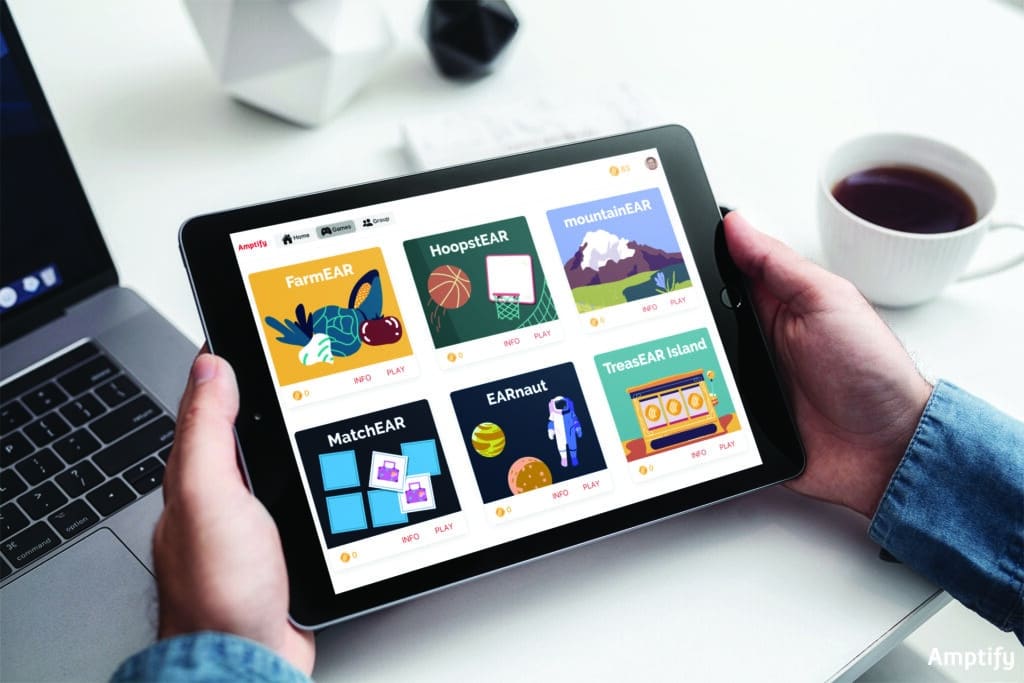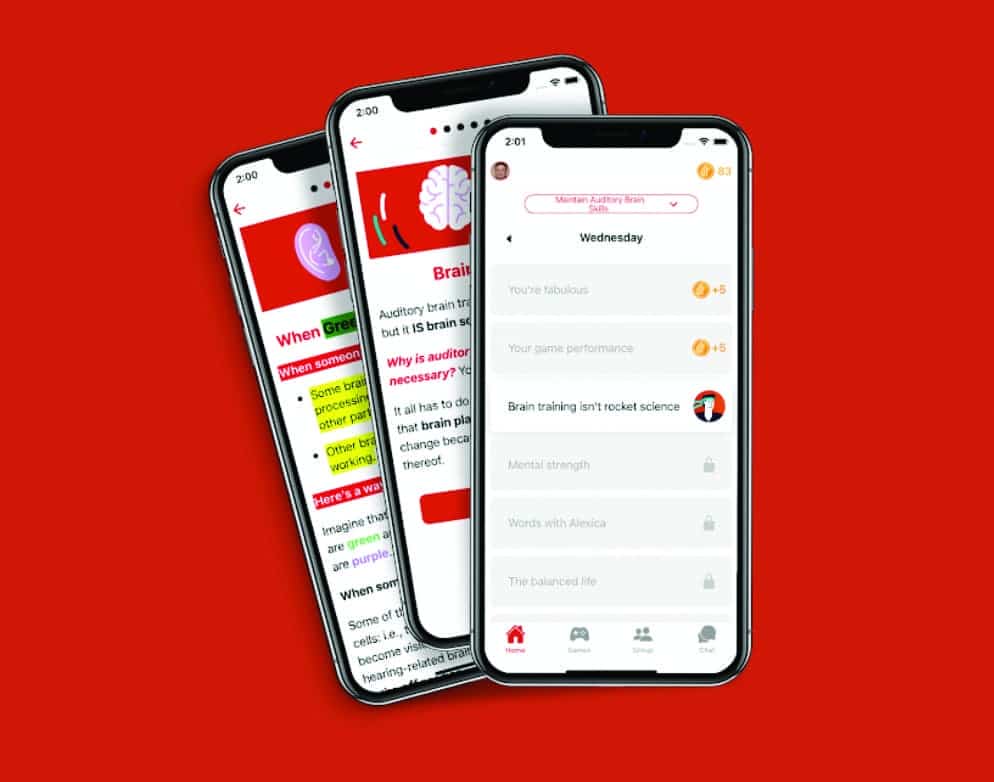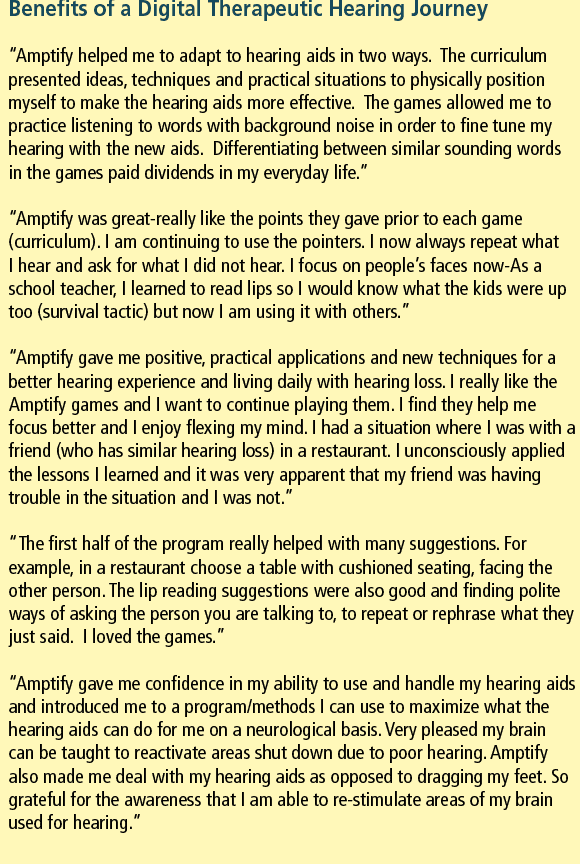Developed under an NIH research grant, Amptify is an online aural rehabilitation program and Hearing Health Coach that engages patients and enhances the new hearing aid experience without incurring additional time on the part of a patient’s audiologist. As teleaudiology becomes more commonplace, it is highly likely that Amptify will be the first of many digital therapeutics for the treatment of hearing loss.
Tech Topic | May 2021 Hearing Review
By Nancy Tye-Murray, PhD
Five years ago, Brent Spehar, PhD, and I launched clEAR in order to provide auditory brain training via a gaming-type interface to every adult in America who needs it.1 clEAR stemmed from our NIH-sponsored research completed at the Washington University School of Medicine which allowed us to present computerized auditory training to patients via the Internet.
The games were designed to exercise speech discrimination skills, discourse comprehension, and auditory cognitive skills necessary for speech recognition, including auditory attention, auditory processing speed, and auditory memory. Whereas the training was not intended to either change hearing acuity or cognitive capacity per se, it did aim to marshal and coordinate a user’s auditory and brain resources for recognizing speech under challenging circumstances (ie, in the presence of hearing loss and sometimes in the presence of background noise).
The key goal of clEAR was to give hearing care professionals a way to “outsource” aural rehabilitation so they could focus on the sensory management (eg, diagnostics and dispensing hearing aids) and instruction for listening devices. Through the clEAR gaming system, we would provide the evidence-based aural rehabilitation that includes auditory training, counseling, and hearing aid adjustment.
We learned much from our experience with clEAR. In particular, we learned that auditory training cannot be rote and drill-like; rather, auditory training must be engaging and engrossing. If it is not, users will either not comply with training (hence the complaint, “It’s boring!”), or if they do, the neurotransmitters necessary for perceptual learning will not be released in their brain. In a nutshell, training must be a pleasurable experience in order to potentiate perceptual learning and neural plasticity while ensuring compliance.
We also learned that users are more likely to engage in training if they know that a professional is paying attention to their training schedules and progress in an ongoing fashion. Finally, through the text messages that passed between our users and our in-house hearing care professionals (HCPs), we learned that our users appreciated the social interaction with their HCP and the opportunity to ask questions about managing hearing loss and related co-morbidities, such as tinnitus and balance problems.
These insights inspired us to create Amptify, the first-ever digital therapeutic for hearing loss. It includes:
- Both new and revised auditory and cognitive training games that are professionally crafted to ensure compliance and entertainment (Figure 1);
- A daily interactive, illustrated curriculum that engages patients with captivating quizzes, tutorials, and social diaries (Figure 2);
- A certified online Amptify Hearing Health Coach for each patient, who provides support, encouragement, and hearing-related information, and
- A customized social peer support community with conversations led by a Hearing Health Coach.

Figure 1. The palette of games includes FarmEAR, HoopsEAR, MountainEAR, MatchEAR, EARnaut, and TreasEAR Island.

Figure 2. A daily curriculum is provided along with the opportunity to interact with the patient’s own Hearing Health Coach.
Amptify is a lifestyle enhancer that integrates into the daily routine of a person living with hearing loss. Our NIH-sponsored research showed that the Amptify auditory training game instructional designs improved speech discrimination, improved listening confidence, and reduced perceptual effort and communication challenges.2-6
Most recently, we conducted a qualitative study about the benefits of Amptify under the auspices of an NIH NIA SBIR grant. The study entailed providing new hearing aids to patients who had never used them before. A total of 28 adults received two new Intricon hearing aids at the onset. All participants provided a recent audiogram. Due to the pandemic, the hearing aids were fitted remotely and entailed Zoom calls between the project audiologist and the participant. The fittings were then objectively verified.
After a 2-week adjustment period, half of the participants received Amptify for 4 weeks and the other half waited 4 weeks before beginning their Amptify program. At the end of the study, participants filled out a questionnaire about their experiences. The questionnaire included rating scales and open-ended follow-up questions, as well as open-ended questions. The response scale ranged from 1 (disagree/negative) to 7 (agree/positive), so anything above a 4 was considered a “positive response.” The open-ended and follow-up responses were analyzed using qualitative methodology.
The quantitative results are presented in Table 1. There were no differences found in the responses between the two groups, so data are combined for both. Items that pertained to development of the software and the corresponding results are not included in this table (eg, Which game did you like best? Least?). Results indicated a very positive response to the Amptify digital therapeutic overall and to the curriculum in particular, with the latter receiving a rating of 6.1 out of a possible score of 7. A total of 96% of the participants reported positive benefits, and one-half reported the program helped them to adjust to their new hearing aids. Examples of the types of positive benefits are presented in Table 2 in the form of quotes.

Table 1. Responses to selected questionnaire items based on a 7-item scale (1 = disagree/negative; 7 = agree/positive).

Table 2. User comments about Amptify.
In summary, the results suggest that Amptify enhances the new hearing aid experience without incurring additional time on the part of a patient’s audiologist. In addition, the results indicate that the HCPs have flexibility in terms of when they enroll patients, and the program may be initiated any time during the fitting and adjustment period. Our next round of research will address whether Amptify can reduce in-clinic time with patients due to the online Amptify Hearing Health Coach being available to answer basic questions about hearing aid use (eg, battery life or device handling).
HCPs can enroll patients either by referring them to www.Amptify.com so they can self-pay or they can sponsor their patients via their own clinic’s Amptify portal. Amptify provides brochures to clinics and a “cheat sheet” about how to describe the program. The app can be accessed on iOS, Android, or at app.Amptify.com. The formal curriculum lasts anywhere from 12-16 weeks and then patients can continue to use the auditory training games. As teleaudiology becomes more commonplace, it is highly likely that Amptify will be the first of many digital therapeutics for the treatment of hearing loss.
Acknowledgement
This research was supported by NIA SBIR grant 1R43AG065075.

Correspondence can be addressed to Dr Tye-Murray at: [email protected].
Citation for this article: Tye-Murray N. A digital therapetic and hearing health coach for enhancing first-time hearing aid experiences. Hearing Review. 2021;28(5):25-26.
References
- Tye-Murray N. Gaming technology for customized aural rehabilitation and hearing healthcare. Hearing Review. 2016;23(11):20
- Barcroft J, Spehar B, Tye-Murray N, Sommers M. Task- and talker-specific gains in auditory training. J Sp Lang Hear Res. 2016;59(4):862-870.
- Sommers MS, Tye-Murray N, Barcroft J, Spehar BP. The effects of meaning-based auditory training on behavioral measures of perceptual effort in individuals with impaired hearing. Sem Hear. 2015;36(4):263-272.
- Tye-Murray N, Sommers MS, Mauzé E, Schroy C, Barcroft J, Spehar B. Using patient perceptions of relative benefit and enjoyment to assess auditory training. J Am Acad Audiol. 2012;23(8):623-634.
- Tye-Murray N, Spehar B, Barcroft J, Sommers M, Barcroft J. Auditory training with frequent communication partners. J Sp Lang Hear Res. 2016;59(4):871-875.
- Tye-Murray N, Spehar B, Barcroft J, Sommers M. Auditory training for adults who have hearing loss: A comparison of spaced versus massed practice schedules. J Sp Lang Hear Res. 2017;60(8):2337-2345.





